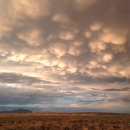Integrating Habitat Quality and Resistance and Resilience to Inform Long-term Sagebrush Conservation and Restoration Investments
Funding Year | Amount | Location |
FY24 | $244,418 | Rangewide |
Project Description
In the context of climate change climate change
Climate change includes both global warming driven by human-induced emissions of greenhouse gases and the resulting large-scale shifts in weather patterns. Though there have been previous periods of climatic change, since the mid-20th century humans have had an unprecedented impact on Earth's climate system and caused change on a global scale.
Learn more about climate change and invasive species invasive species
An invasive species is any plant or animal that has spread or been introduced into a new area where they are, or could, cause harm to the environment, economy, or human, animal, or plant health. Their unwelcome presence can destroy ecosystems and cost millions of dollars.
Learn more about invasive species , conservation and restoration investments in the sagebrush sagebrush
The western United States’ sagebrush country encompasses over 175 million acres of public and private lands. The sagebrush landscape provides many benefits to our rural economies and communities, and it serves as crucial habitat for a diversity of wildlife, including the iconic greater sage-grouse and over 350 other species.
Learn more about sagebrush region will have the greatest benefit if they recognize the current conditions and future trajectories in both habitat quality and ecological resistance/resilience. This project will integrate recent results about both habitat quality and resistance and resilience and utilize the Resist-Accept-Direct climate adaptation framework to provide spatially-explicit information on strategies to sustain sagebrush ecosystems.
Partners
United States Geological Survey



